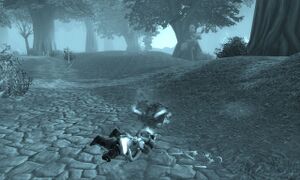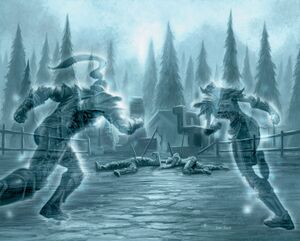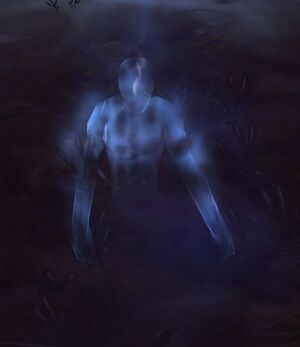Death (gameplay)
- This article is about death as a gameplay mechanic. For Death as a cosmic force, see Death. For cultural practices related to death, see funerary practices.
“No matter how good an adventurer you are, eventually you will know the sting of death. Thankfully, death in the World of Warcraft isn't permanent.”
Death is the state a character is in when their health reaches zero (or less). When a player dies, they are unable to take further actions until they release their spirit or are resurrected. Dead players leave a corpse at the location where they died.
In World of Warcraft

Upon dying, the player is presented with two options: Release Spirit and Recap. The Death Recap Screen provides a short list of the most recent sources of damage, allowing the player to review their cause of death. Repeated deaths within a short time will cause a "resurrection timer" to appear, which temporarily grays out the Release Spirit button (likely to prevent zerging). After 6 minutes the player's spirit will automatically be released.
When the player's spirit is released, they will turn into a spirit form (a ghost or, in the case of night elves, a wisp), which spawns at the nearest graveyard. A player in ghost form appears as a blueish-gray, transparent version of their normal model (with the exception of Shadowlands zones, where all players instead appear as featureless humanoid souls). As a ghost, you will only have 1 point of health. Death will automatically remove all Buffs and Debuffs from the character, except for the "ghost" debuff, which is applied, and certain Flask effects that persist through death.
A character will stay dead until they are resurrected. This can be achieved through returning to their corpse as a spirit; by the spirit healer at a graveyard; by a player character near the corpse; or by using an item such as ![]() [Darkmoon Card: Twisting Nether].
[Darkmoon Card: Twisting Nether].
While you are dead, there are some interesting graphical effects. The sky looks like a whirlpool, and everything you see gets a little more grey. This is called the Veil and is lore-wise one of the many "planes" in the Warcraft-universe.
If you die in an inaccessible area, such as falling off Outland or far past the Fatigue limit in the ocean, your ghost may not be able to get close enough to your corpse to rejoin it. In this case, you will have to resurrect at a graveyard (when falling off of Outland, the corpse of the player usually is placed at a reachable area on the edge somewhere. It may, however, place the corpse in an unpleasant location).
If you die in an instance and release your spirit, you will instantly be revived without having to fetch your corpse, no matter where you died in the instance. You will also be returned to the place where players begin the instance - this makes it impossible to corpse run past mobs in instances. Some instances have portals at the start which can teleport players to locations within the instance to save time. Something else to note is that when you are dead, you can pass through any gates, barriers, and instance doors (if any).
The term "corpse running", aka "ghost running", originally described an exploit to travel to certain areas while dead (thus being immune to damage) but now refers to the distance a player would have to cross from the graveyard to their corpse. This may even have an effect on how willing players are to reattempt entering dangerous areas. For example, dying in Blackrock Mountain-instances previously sent the player to the graveyard at Thorium Point, which is located on nearly the other side of the zone. As a result, many players were hesitant to play in that location with inexperienced players because it could cause repeated deaths and the time-consuming run back. Later, (possibly in Cataclysm) the location was placed at Forgewright's Tomb which made the distance much shorter.
Durability as a ghost
When your ghost is killed, you suffer another 10% durability loss on equipped items. For example, if you are killed in combat and you get your ghost killed trying to rejoin your corpse (now having died twice), then give up and use the spirit healer, you would suffer a 3x10+25 = 55% durability loss on all equipped items and 25% on inventory items.
- From Death section of the New Player Guide:
Upon dying in World of Warcraft, all of your equipped items immediately take a 10% durability reduction (this applies only to items equipped when you died, not to items in your inventory). You have a few minutes in which to be resurrected by a player, or you may release yourself to the nearest graveyard as a spirit. While in spirit form, you can run back to your corpse and rejoin it for no additional penalty by selecting the "Resurrect Now" button when you come within range; you come back to life with half health and half mana. Run speed is increased to 125% of normal while you are a spirit (night elves have a special racial ability called ![]() [Wisp Spirit] that gives them even more speed) and you are able to walk on water.
[Wisp Spirit] that gives them even more speed) and you are able to walk on water.
Your ghost can breathe underwater in lakes, rivers, coastal waters, and even lava, but if you swim into the deep ocean your ghost can still, ironically, die of Fatigue. Dying while already being dead will return you to the graveyard.
Exceptions to the rules on durability loss
If you are killed by another player in PvP combat, you do not take the initial 10% durability hit. However, you will still take a 25% hit and suffer from resurrection sickness if you are resurrected by a spirit healer.
If you are killed by self-inflicted death — such as a Warlock's ![]() [Hellfire], using a life-draining item like a
[Hellfire], using a life-draining item like a ![]() [Demonic Rune] — then you will not suffer any durability damage to your armor or items unless you are resurrected by a spirit healer.
[Demonic Rune] — then you will not suffer any durability damage to your armor or items unless you are resurrected by a spirit healer.
Spirit healers
- For lore page, see Spirit Healer.
The spirit healers present in each graveyard can bring you back to life immediately, saving you a trip to your corpse. However, doing this will cause all of your equipable items to take an additional 25% durability hit; this applies both to equipped items, and to items in your inventory. In addition, you will suffer from ![]() [Resurrection Sickness]. This sickness decreases all of your attributes and damage dealt by 75%.
[Resurrection Sickness]. This sickness decreases all of your attributes and damage dealt by 75%.
- Characters from level 1-10 are not affected (however, they still take the additional durability decrease).
- Characters of all other levels are affected for one minute.
Players that have the resurrection sickness debuff will be worth no ![]() [Honor] when killed by a player of the opposite faction.
[Honor] when killed by a player of the opposite faction.
In some zones, spirit healers are replaced by other NPCs who offer the same functionality, such as Prime Naaru on Argus or Spirit Obelisks in the Shadowlands.
Quests accessed while dead
There are a few quests that can only be accessed while the player is dead. Those quests start by talking to an NPC (non-player character) who is only visible and accessible while in ghost/wisp form. On a side note, if one levels due to turning in one such quest, they shall regain all their life and mana but will not resurrect (which is a bit weird).
Known quests
- Molten Core Attunement Quest:
 [30D] Attunement to the Core - (can be acquired while dead, death not required)
[30D] Attunement to the Core - (can be acquired while dead, death not required)  [15-30] Chill Out, Mon
[15-30] Chill Out, Mon [52] A Grave Situation
[52] A Grave Situation
Notes and trivia
- The death effect depends on graphics settings; lower-end systems may not properly gray out the world while dead.
- Typing
/console ffxDeath 0will turn off the death effect.
- Typing
- Diying and releasing in an instance originally teleported the character to the nearest graveyard. From there, you had to run back to the instance and reenter it to be able to recover your corpse.
- In Wrath of the Lich King, when dying in Icecrown or Storm Peaks and other places players will have access to a spectral gryphon upon death to retrieve their corpse because you cannot always climb the mountainous regions. However, since Night Elves are wisps they don't have the gryphon, they can simply fly.
- No such system exists in Outland if one dies in a location inaccessible without flying then the player is resurrected at the nearest graveyard without the usual penalty for doing so.
- During the Second Scourge Invasion event, there was a glitch, when you stayed long enough as a zombie, you would NOT take durability damage.
- Although a player can easily get back into the instance if they died within it, if a player dies outside an instance they cannot get into one this way.
- A player can die from fatigue while already dead.
- For various reasons, the player may fall through or under the game world, usually resulting in death after a long fall. The effect of dying in this way is identical to falling off the zone like Outland or Argus. After releasing, the player's corpse is moved above ground to make returning to it possible. In some cases, the corpse is not moved and the player is forced to resurrect using a Spirit Healer. Because players are not expected to end up under the game world, zones are not accurately defined there. As a result, the player may find themselves very far from their corpse after releasing.
Patch changes
 Patch 6.1.0 (2015-02-24): If you die, there is a Recap button. If you click on that button you will see a list of mobs in a Death recap screen, their abilities and the amount of damage that caused you to die. In the Chat frame the text [You die.] is added on which you can click. Doing so will give the recap information of that moment you died.
Patch 6.1.0 (2015-02-24): If you die, there is a Recap button. If you click on that button you will see a list of mobs in a Death recap screen, their abilities and the amount of damage that caused you to die. In the Chat frame the text [You die.] is added on which you can click. Doing so will give the recap information of that moment you died.  Patch 1.6.0 (2005-07-12): Health leech effects no longer give you health while you are a ghost.
Patch 1.6.0 (2005-07-12): Health leech effects no longer give you health while you are a ghost.  Patch 0.6 (2004-04-13):
Patch 0.6 (2004-04-13):
- Bodies will decompose after a player is resurrected or revived.
- The corpse retrieval area has increased to 40 yards.
- Players that revive will now have 50% health and mana.
- Players can no longer use ghost form as a means to travel to far off locations. Having a spirit healer resurrect you in a graveyard other than the one you appeared at when you died, will always teleport you back to that initial graveyard.
- Players can now use all of the UI in ghost form (i.e. move things around in your backpack, read your quest log, interact with your spellbook etc.)



